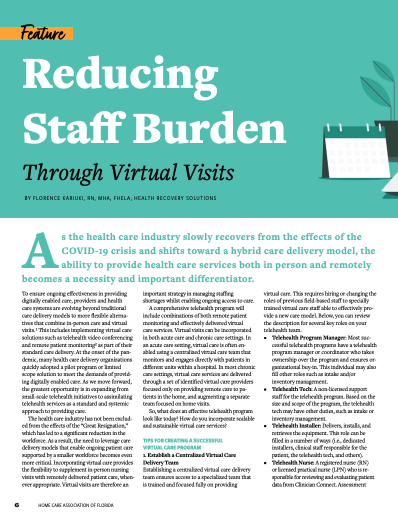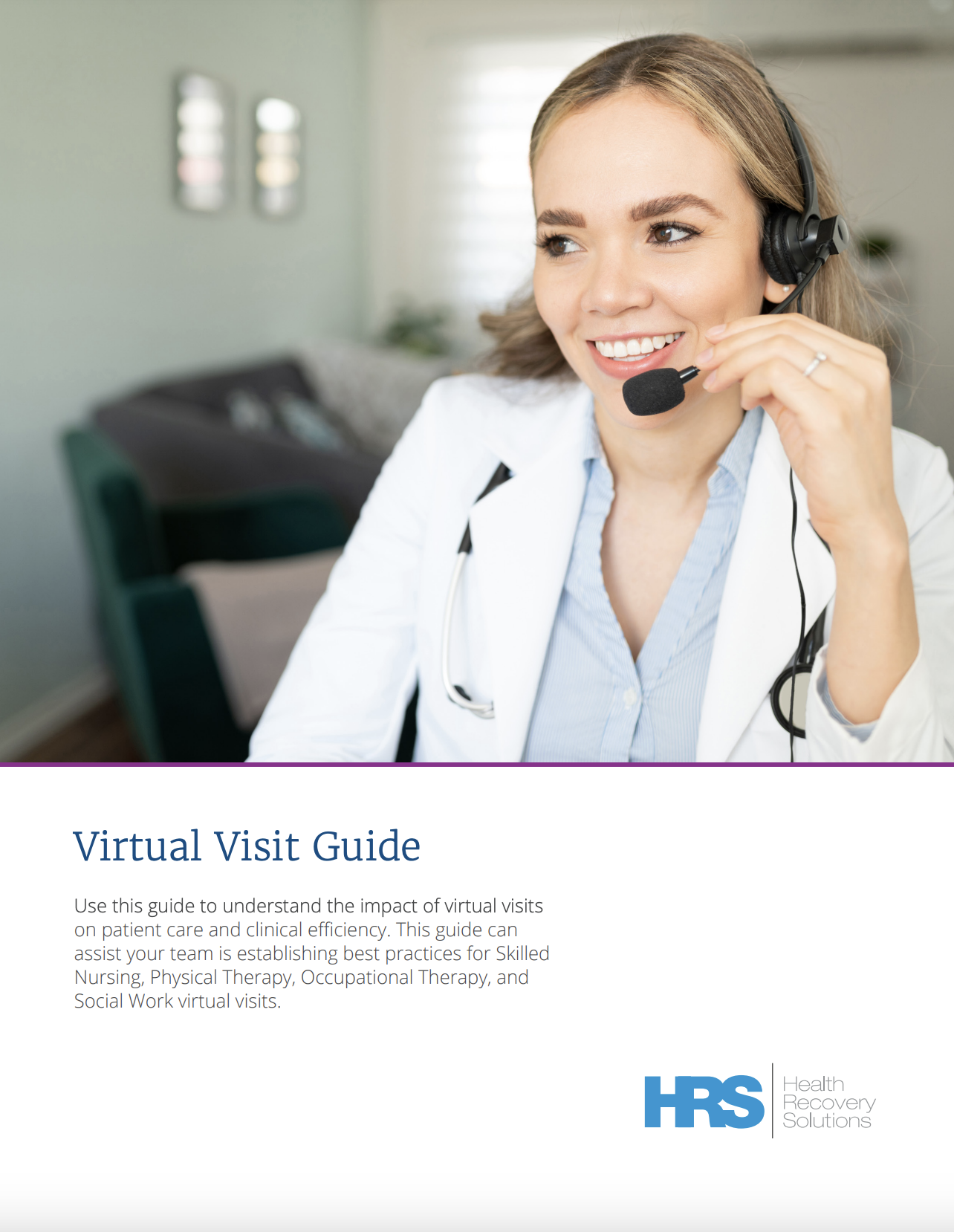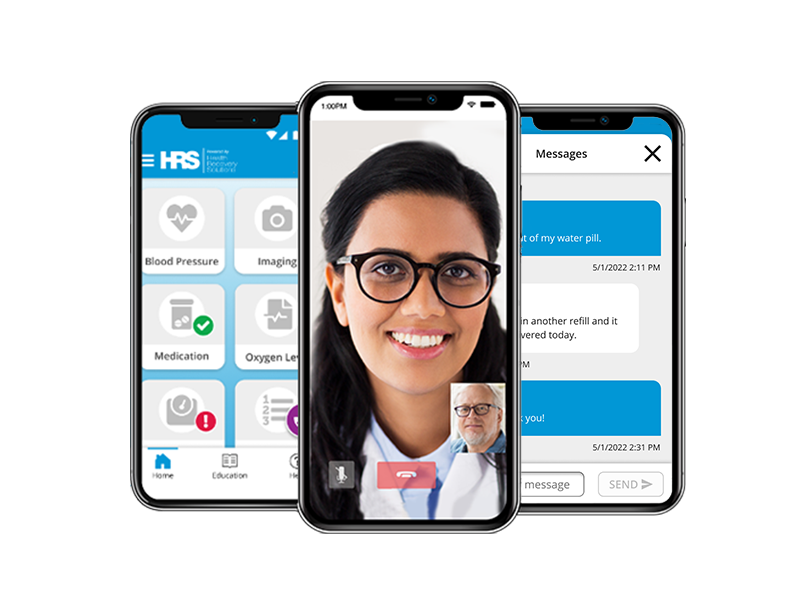In this article, originally featured in the Summer 2022 edition of Florida at Home magazine, HRS Chief Clinical Officer, Florence Kariuki, walks through the nursing benefits of a Virtual Visit Model (VVM) and the six steps to launching a VVM.
As the healthcare industry slowly recovers from the effects of the COVID-19 crisis and shifts toward a hybrid care delivery model, the ability to provide healthcare services both in person and remotely becomes a necessity and important differentiator.
To ensure ongoing effectiveness in providing digitally enabled care, providers and healthcare systems are evolving beyond traditional care delivery models to more flexible alternatives that combine in-person care and virtual visits. This includes implementing virtual care solutions such as telehealth video conferencing and remote patient monitoring as part of their standard care delivery. At the onset of the pandemic, many healthcare delivery organizations quickly adopted a pilot program or limited scope solution to meet the demands of providing digitally-enabled care. As we move forward, the greatest opportunity is in expanding from small-scale telehealth initiatives to assimilating telehealth services as a standard and systemic approach to providing care.
The healthcare industry has not been excluded from the effects of the “Great Resignation,” which has led to a significant reduction in the workforce. As a result, the need to leverage care delivery models that enable ongoing patient care supported by a smaller workforce becomes even more critical. Incorporating virtual care provides the flexibility to supplement in-person nursing visits with remotely delivered patient care, whenever appropriate. Virtual visits are therefore an important strategy in managing staffing shortages whilst enabling ongoing access to care.

Featured in the Florida at Home Magazine
This article originally appeared in the Summer 2022 edition of the Florida at Home Magazine, produced by the Home Care Association of Florida. View the article in its original format using the link below.
A comprehensive telehealth program will include combinations of both remote patient monitoring and effectively delivered virtual care services. Virtual visits can be incorporated in both acute care and chronic care settings. In an acute care setting, virtual care is often enabled using a centralized virtual care team that monitors and engages directly with patients in different units within a hospital. In most chronic care settings, virtual care services are delivered through a set of identified virtual care providers focused only on providing remote care to patients in the home, and augmenting a separate team focused on home visits.
So, what does an effective telehealth program look like today? How do you incorporate scalable and sustainable virtual care services?
Tip for Creating a Successful Virtual Care Program
1. Establish a Centralized Virtual Care Delivery Team
Establishing a centralized virtual care delivery team ensures access to a specialized team that is trained and focused fully on providing virtual care. This requires hiring or changing the roles of previous field-based staff to specially trained virtual care staff able to effectively provide a new care model. Below, you can review the description for several key roles on your telehealth team.
- Telehealth Program Manager: Most successful telehealth programs have a telehealth program manager or coordinator who takes ownership over the program and ensures organizational buy-in. This individual may also fill other roles such as intake and/or inventory management.
- Telehealth Tech: A non-licensed support staff for the telehealth program. Based on the size and scope of the program, the telehealth tech may have other duties, such as intake or inventory management.
- Telehealth Installer: Delivers, installs, and retrieves the equipment. This role can be filled in a number of ways (i.e., dedicated installers, clinical staff responsible for the patient, the telehealth tech, and others).
- Telehealth Nurse: A registered nurse (RN) or licensed practical nurse (LPN) who is responsible for reviewing and evaluating patient data from a dashboard like ClinicianConnect®. Assessment and intervention strategies are based on best practices for the targeted population. The telehealth nurse had been specially trained in managing high-risk and targeted populations.
2. Expand Virtual Care Services to Include Specialists and Ancillary Care Providers
Expanding virtual care to specialty physicians is crucial to ensuring comprehensiveness and continuity of care, particularly for advanced conditions that require ongoing monitoring or regular follow-ups. Incorporating specialists discourages care fragmentation and ensures that important aspects of the patient’s treatment, disease progression, and self-management involve the patient’s specialists. In addition to specialty physicians, virtual care services can also be provided by ancillary providers. Some examples include home-based rehabilitation such as physiotherapy, occupational therapy, speech therapy, and mental health services (e.g., psychiatric treatment, counseling, and bereavement support).
With virtual visits, patients and specialists can easily connect in real-time without a long drive to the clinic or hospital for a half-hour appointment. From there, the provider can determine if an in-person visit will eventually be necessary, or if the patient needs to undergo any surgical procedures.

Home Health Virtual Visit Guide
This comprehensive, 15-page guide can assist your team is establishing best practices for Skilled Nursing, Physical Therapy, Occupational Therapy, and Social Work virtual visits that would otherwise be conducted in person in the patient's home.
3. Develop Policies and Procedures for Your Virtual Care Services
Policies and procedures help to standardize your services and increase staff compliance with the new model. They provide clear guidance for your internal processes and support consistent decision-making across your staff. For your new care model to be successful, outlining virtual service guidelines should be augmented with monitoring for adherence.
4. Train Your Team for Appropriate ‘Webside’ Manners
For many patients and clinicians, virtual visits are a whole new experience. When providers conduct telehealth visits without any training, related experience, or knowledge of virtual visit best practices, they may struggle to build trust and rapport with patients, affecting the clinician-patient relationship. Proper webside manners involve more than just a professional appearance. A good webside manner puts equal emphasis on objective factors such as the quality of the video, how one is positioned as they look into the camera, and subjective factors such as how well one conveys empathy virtually. Effective webside manner will ensure that patients feel effectively evaluated and cared for while giving clinicians the confidence to gather information and provide care virtually.
5. Obtain Organizational Buy-in
Gaining organizational buy-in is key to the success of any new endeavor. Communicating the goals and benefits of virtual care, as well as the risks of not embracing it as an integral part of healthcare delivery, will improve staff buy-in and organization-wide transformation.
To ensure the continuity and success of your telehealth program, staff should be provided with the appropriate enablement tools and resources to facilitate model implementation. Tracking and monitoring key performance indicators for adoption and sharing progress with staff ensure that opportunities for improvement are addressed in a timely fashion. Leaders should also set short-term and long-term virtual care program goals that will be tracked and communicated with staff. As the proverbial saying goes, what is measured will improve.
Southcoast VNA saves an average of 4 in-home nursing visits leveraging virtual visits & remote patient monitoring with a 7% 30-day rehospitalization rate for 2,621 patients over the last 16 months.
Build and Scale Your Virtual Telehealth Program with HRS
An effective telehealth and remote patient monitoring platform should help simplify your transition to providing virtual care services, allowing you to focus on improving patient outcomes and optimizing clinician workflows. HRS’ industry-leading telehealth and remote patient monitoring solution offers advanced virtual care solutions that are secure, scalable, and easy to use. See how HRS’ platform and advisory services can help your organization deliver successful hybrid care services!

Connect with the HRS team
Learn more about how virtual visits can support your patients and staff by scheduling your custom demonstration with an HRS Digital Health Advocate.